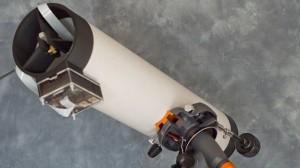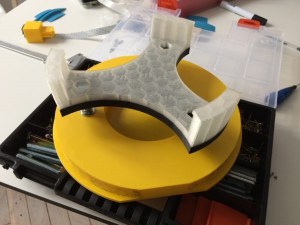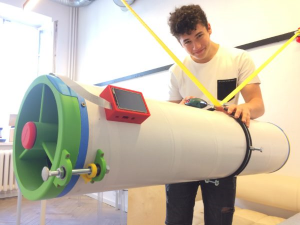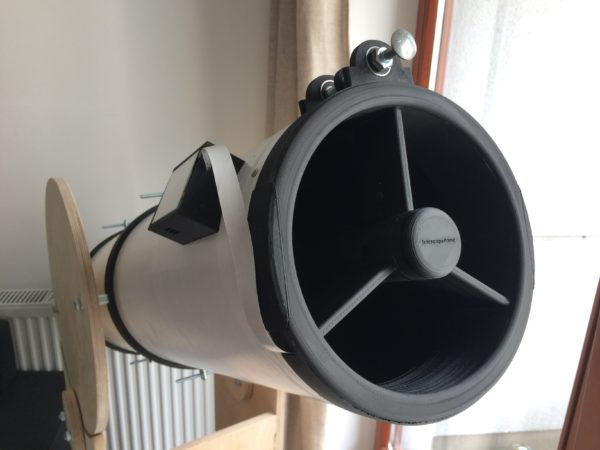While the majority of us are not astronauts, there is a tool that can be used in your home to make you feel like you’re just a little bit closer to the stars – the telescope. Five years ago, a group of UK researchers from the University of Sheffield, including physicist Mark Wrigley, were inspired by NASA’s Juno spacecraft to create their own DIY telescope, the PiKon, using 3D printing and a Raspberry Pi. Now, a pair of Polish scientists have followed in their footsteps with their own parametric, open source, DIY telescope with 3D printed parts.
Aleksy Chwedczuk and Jakub Bochiński wanted to help popularize astronomy by making their own semi-professional, yet affordable, telescope model for at-home use, for which people can then download the files and create on their own. Chwedczuk and Bochiński call their creation the Telescope Prime, and created the first prototype in just eight hours. The initial prototype was then used to take pictures of the moon, and the final version was finished in less than three months.
Polish 3D printing company Sygnis New Technologies offered to help the scientists create their DIY telescope by sharing their equipment.
“As Sygnis New Technologies, we are proud to say that we have participated in the Telescope Prime project by adjusting 3D models of parts of the telescope and printing them for the science duo,” Marek Kamiński, the Head of Social Media for Sygnis New Technologies, told 3DPrint.com.
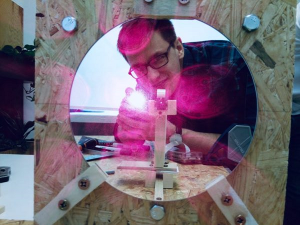 Telescopes have been helping people observe outer space since the 17th century, though at that time it was reserved only for the elite citizens who could purchase the equipment. But even though there is much more variety available today, it’s still not something that is widely available – the device has many complex, interacting elements. That’s why Chwedczuk and Bochiński wanted to use 3D printing to help create a more affordable, open source version.
Telescopes have been helping people observe outer space since the 17th century, though at that time it was reserved only for the elite citizens who could purchase the equipment. But even though there is much more variety available today, it’s still not something that is widely available – the device has many complex, interacting elements. That’s why Chwedczuk and Bochiński wanted to use 3D printing to help create a more affordable, open source version.
In a piece by Sygnis, the two scientists said, “We wanted to initiate the development of an open-project telescope that could be easily modified and expanded…
“At the same time, it should be a digital telescope – adapted to our 21st century online lifestyle, where the habit of sharing one’s experiences on the Internet is the new norm.”
The telescope model, which all together costs less than $400 to put together, is made of three main parts: the 20 cm diameter parabolic mirror (with a recommended focal length of 1 m), a Raspberry Pi microcomputer with a camera and touch display, and 3D printed parts that are used to fix the camera and the mirror. To help keep costs down, “readily available materials,” like wood, screws, and a paper tube, are used to build the Telescope Prime.
In a further effort to keep the telescope fabrication as inexpensive as possible, it does not have lenses. Light is focused in a single spot, and stops on the mirror. A boarding tube makes up the body of the device, and plywood parts are then added. The telescope can use its build-in camera to take images of the night sky, and transmit them online in real-time using the touchscreen of a computer, projector, or tablet. Additionally, you can easily increase and reduce the size of the telescope – just enter the mirror’s size into the program, and all of its dimensions will be automatically converted.
“The creators had to take into account the realities of the 21st century, modern issues of the popularization of astronomy, also among the youngest amateurs of the starry sky, as well as the availability of materials for the construction of the telescope,” Sygnis wrote. “Telescope Prime is an innovative idea that reflects the needs and possibilities of an astronomer enthusiast of the second decade of the 21st century.”
The open source models for the telescope parts, which are available for download on the Telescope Prime website, were prepared in advance for 3D printing, so they didn’t need any corrections later. These elements were 3D printed on FlashForge 3D printers out of Orbi-Tech PLA material, and it took a total of 156 hours of printing to create the 17 telescope parts.
Kamiński told 3DPrint.com that the two scientists are currently “promoting the project on Polish universities, schools and science institutes.” This makes sense, as the Telescope Prime website explains that the project was “initiated and fully carried out” on the grounds of the Akademeia High School in Warsaw.
Discuss this story and other 3D printing topics at 3DPrintBoard.com or share your thoughts in the Facebook comments below.
[Source/Images: Sygnis New Technologies]Subscribe to Our Email Newsletter
Stay up-to-date on all the latest news from the 3D printing industry and receive information and offers from third party vendors.
You May Also Like
3D Printing News Unpeeled: A $3000 SLS System, Construction Subsidies and Parameters
The Housing Affordability Crisis is one of Canadian President Trudeau’s biggest issues. Now the government has made subsidies available, including scaling new technologies, 3D printed housing and libraries of reapproved...
“Bundled Light” Enables High Quality Plastic 3D Printing from LEAM
Naturally, we expect current 3D printing methods to continuously improve, but it continues to do so in the most surprising ways. The latest development comes from LEAM, a startup spun...
Each to Their Own: Exploring Creality’s Latest Ender Trio as the Company Strengthens Its Commitment to 3D Printing Advocacy
Creality has reaffirmed its commitment to promoting 3D printing. The launch of the Ender-3 V3 SE, Ender-3 V3 KE, and Ender-3 V3 showcases the company’s dedication to catering to diverse...
3D Printing News Briefs, March 23, 2024: AM in the US Coast Guard, Navy, & More
In today’s 3D Printing News Briefs, we’re discussing the use of 3D printing in various branches of the military, including the U.S. Coast Guard, the U.S. Navy, and the German...


